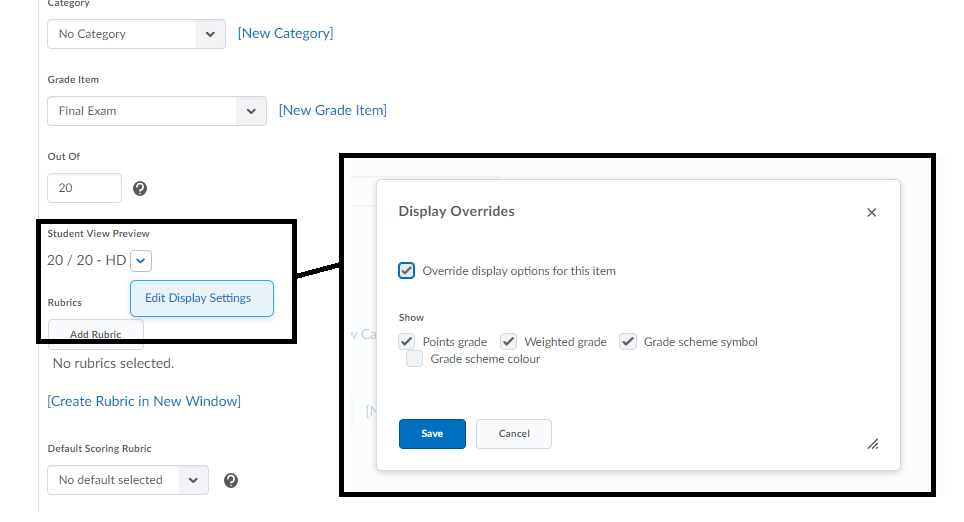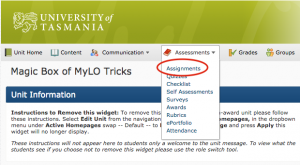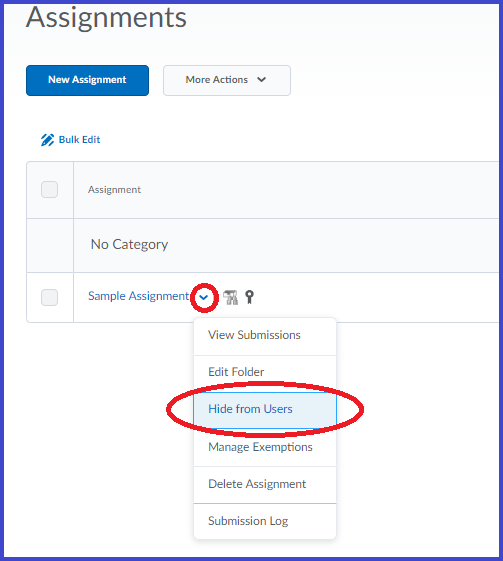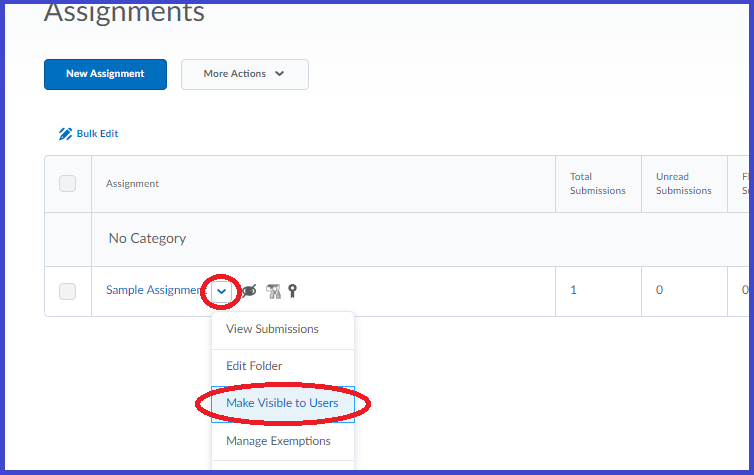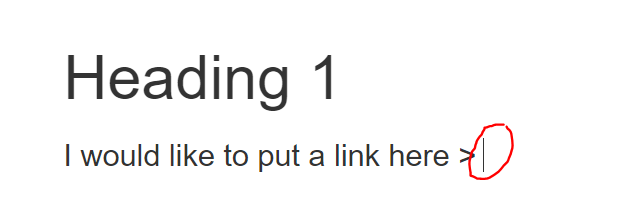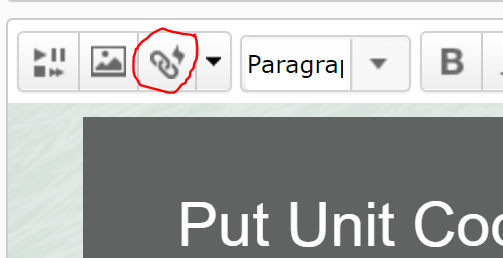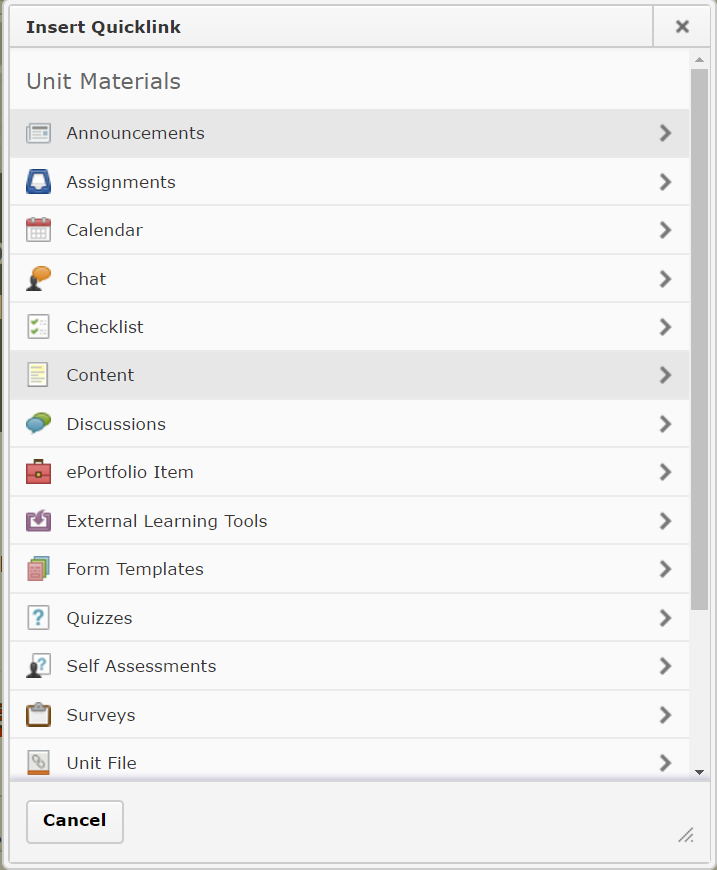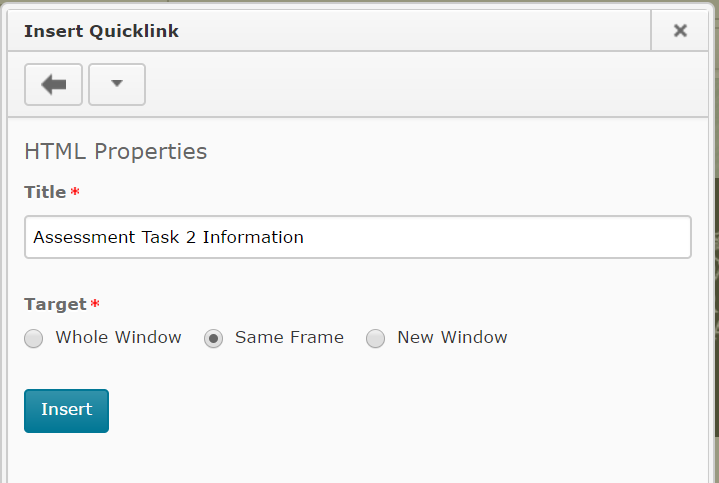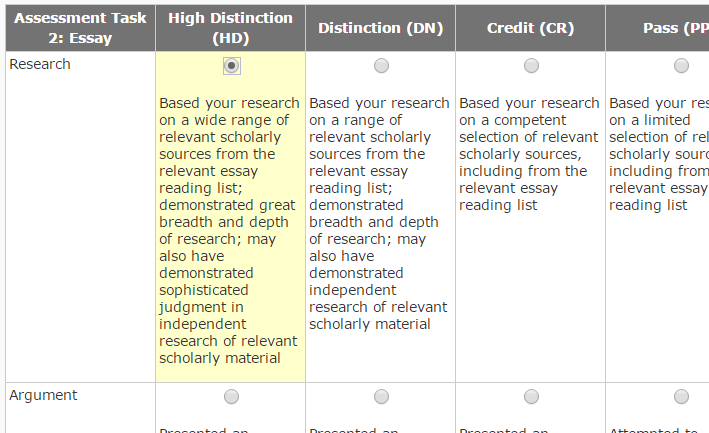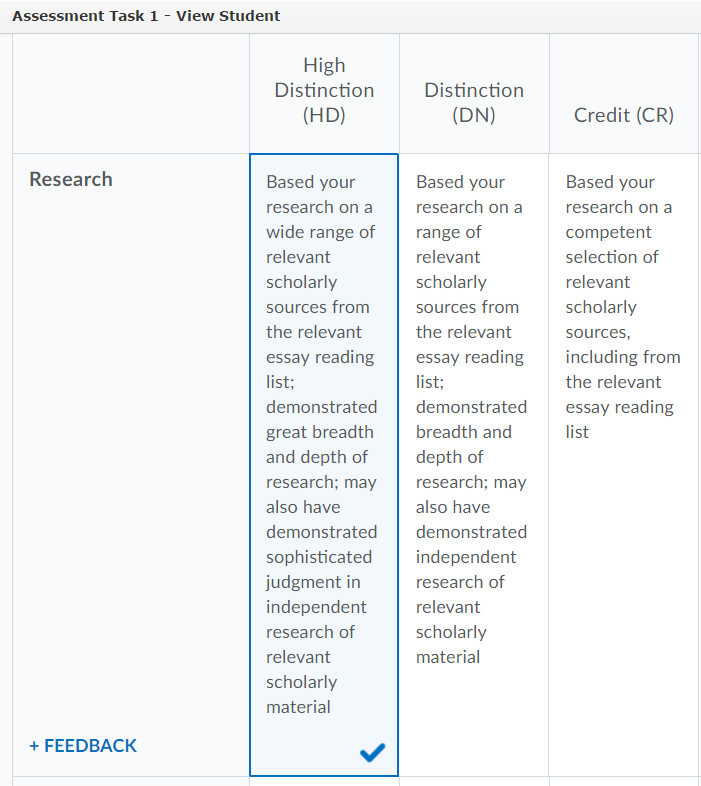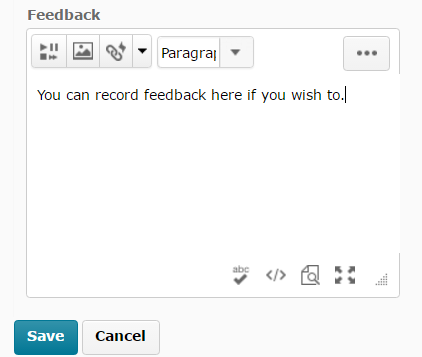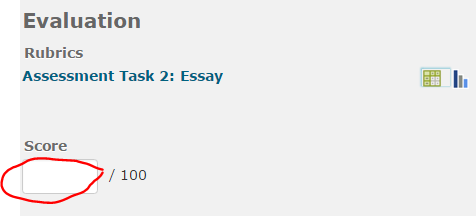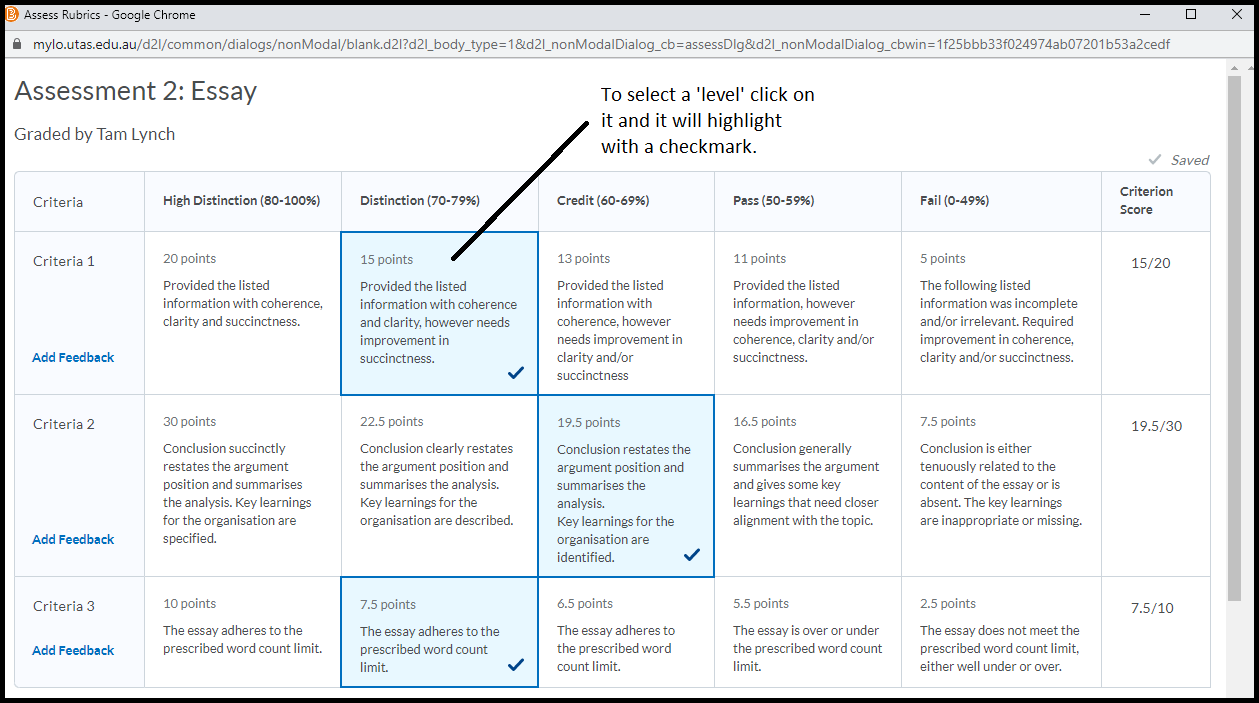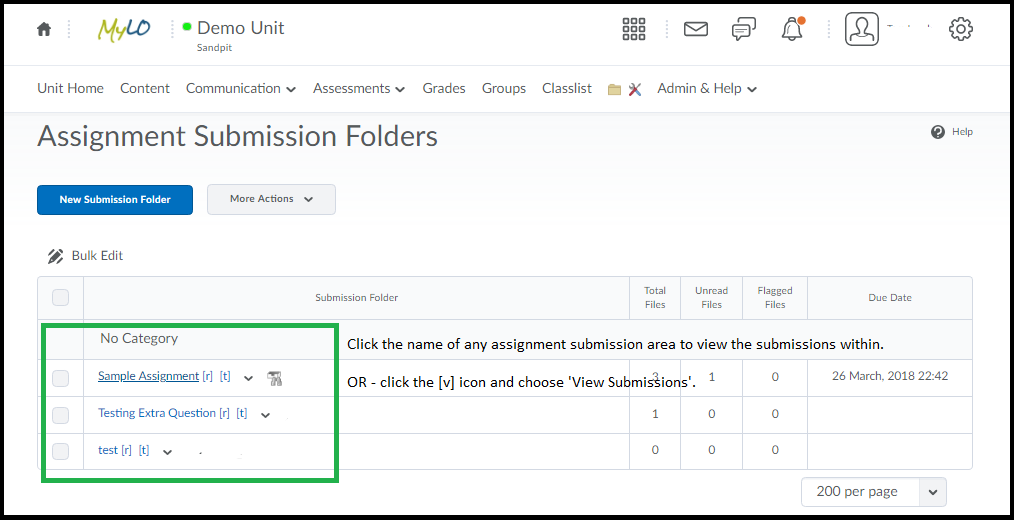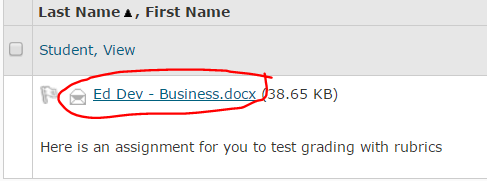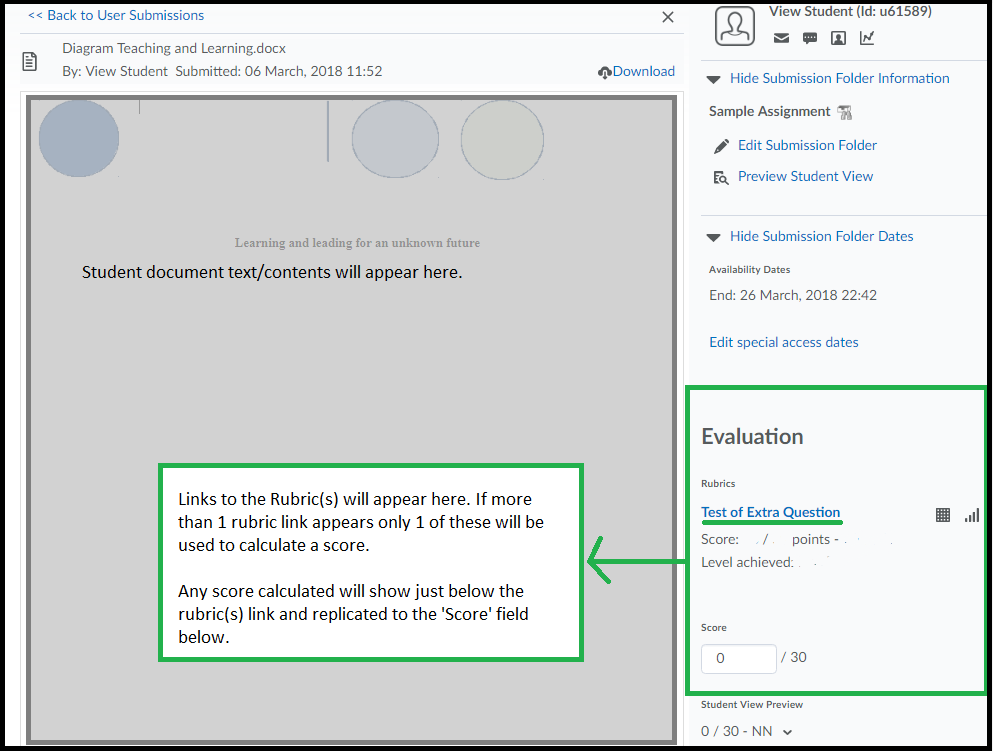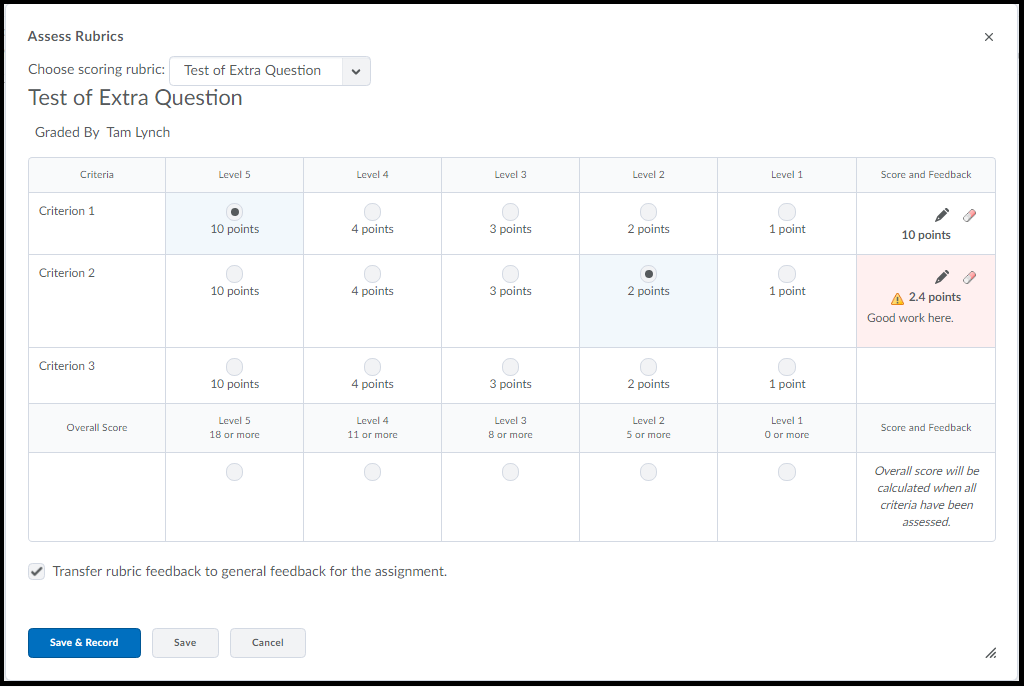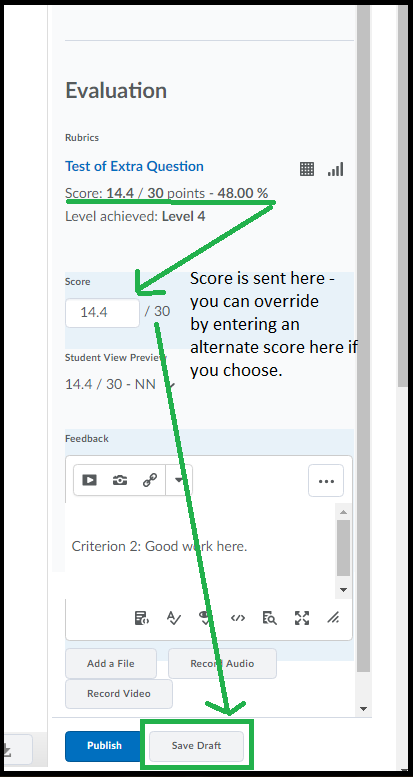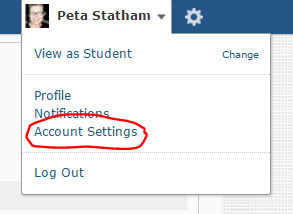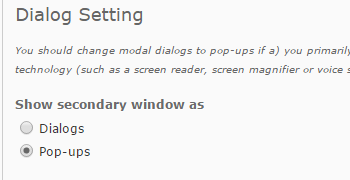Category
MyLO Assignments
Hide Grade from Assignment – While Showing Feedback!
Want to know how to show your Assignment Feedback while hiding the grade?
It can be done (to some extent, note that if you use a rubric they may still figure out their grade via the rubric even if they can’t see the total).
First you need to hide the grade item in the grades tool (so they can’t see it there).
Then edit your assignment settings (click the assignment and choose ‘edit folder’) on the Properties tab go to the “student view preview” and click the icon to the right of it and choose ‘Edit Settings’.
Override the default settings to un-check the score fields. See screenshot below (you can leave on or turn off any option you want) note that ticked items are the ones that show to students.
Your students will now see their feedback but no score, though as noted above they will still see any rubric you’ve used so if you have a scoring rubric this technique may not work for you – even if the scores don’t show a total the rubric may allow them to ‘work out’ what they got (roughly).
Hide (or reveal) an Assignment Submission Folder to students
Sometimes you may need to hide an Assignment Submission Folder from students. You may do this whilst editing elements of a folder, or to hide grades and feedback from students temporarily (e.g. if you need to publish results to Grades without students seeing them in the Assignments tool). Note that is is also advisable to hide the associated Grade Item and ensure that certain Progress Tool settings are switched off. Ask your local support team to help you with this before publishing results from Assignments.
Step 1
Go to the Assessments tab and select Assignments from the menu.
Step 2
Locate the Submission Folder for editing. Select the small black arrowhead to the right of the folder name, then choose Hide from Users.
Your Assignment folder will now be hidden – you will see an icon shown circled below to indicate the status of the folder as ‘hidden from users’.
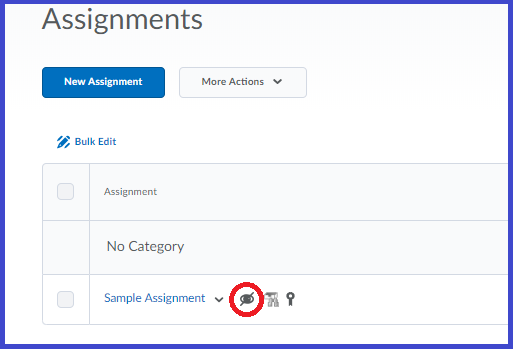
To Reveal the Folder simply click the same icon and choose ‘Make Visible To Users‘ from the options.
(Note that both options are also available in the ‘Restrictions’ tab that is available when editing or creating an assignment submission folder).
Link to items inside, and outside, of your MyLO unit
MyLO includes a powerful tool known as Quicklinks. This tool allows you to link to a range of items inside and outside of your MyLO site. You can use this tool to create links pretty much anywhere in MyLO including Announcements; Descriptions of Modules and Items; HTML Pages; Discussion posts; and feedback in Assignment Submission Folders, Rubrics and Quizzes.
As a general rule, if you can see this icon when creating or editing something, you can use the Quicklinks tool!
In this post, we show you how to insert a Quicklink. including how to choose linking options, in five (5) steps. We then provide a summary of the types of items you can link to, and the best target behaviour to use with each item type.
How to insert a Quicklink and choose your linking options
Step 1
When editing an item in MyLO, place your cursor where you would like the link to appear.
Step 2
Select the Quicklinks tool. It should appear towards the top left of the editing window and will be the third icon from the left hand side.
Step 3
The Insert Quicklink window will open. Select the type of item you wish to insert a link to (for example, here we have selected Content).
Step 4
Work your way through until you have found the item you wish to link to. Select the pencil icon to the left of the item. This allows you to insert a meaningful link text, and control the target behaviour of your link. If you’ve gone too far, use the left-facing arrow symbol (within the Insert Quicklink window) to go back as many times as needed until you reach your preferred option, or press the Cancel button to start again.
NOTE: You cannot select a specific tool or a Content Module to link to. You can only link to items within Tools or Modules. For example, you cannot link to the Assignment Submissions Folder tool, but you can link to an Assignment Submission Folder within the tool.
![]()
Step 5
You should now see two options. You can change the default Title text (usually the name of the item) so that it is more meaningful to students. To do this, simply replace the text in the Title field. You can also change the Target. By default, this will be Same Frame. However, we have found that this target behaviour does not work well with many item types. To see if you should change the Target behaviour for a Quicklink, refer to the table towards the end of this page.
TIP: If using the New Window Target behaviour, include the following phrase at the end of your link Title so students know what will happen when they click on the link: (opens in new window). For example: Access the Week 1 Checklist here (opens in new window).
Once you have chosen your options, select the Insert button. Your Quicklink should now appear in the editing window. Continue to edit as normal and don’t forget to Save your work regularly!
Item types and target behaviours
Please note that we have excluded some Quicklinks options as they do not function effectively or are rarely used at UTAS.
| Item Type | Recommended Target Behaviour | Notes |
|---|---|---|
| Assignments | Whole Window | Link directly to an Assignment Submission Folder. |
| Calendar | Whole Window | Link to a Calendar item. |
| Chat | Whole Window | Link to a Chat room. If you haven’t already created a room, you will have the option to Create New Chat. |
| Checklist | Whole Window/New Window | Link to an existing Checklist, or create a new one by selecting Create New Checklist. It can be useful to open a Checklist in a new window if students need to work through the Checklist whilst completing other activities on the MyLO page where you placed the link. |
| Content | Same Frame | Allows you to link to items seen in Modules in Content. Note that you cannot link directly to a Module (folder) using this tool. Some staff find it easier to have a Materials module that they upload class materials to (e.g. Powerpoint Presentations and PDFs). They then use the Content Quicklink, rather than uploading files ad-hoc via the Unit Files Quicklink tool. |
| Discussions | Whole Window | Allows you to link to Forums (best when you have several Group Topics in the one Forum) or individual Topics.To link to a Forum, locate the Forum, and select it. You will see the Forum name, along with all the Topics included in the Forum. Select the small + icon that appears to the right of the Forum name.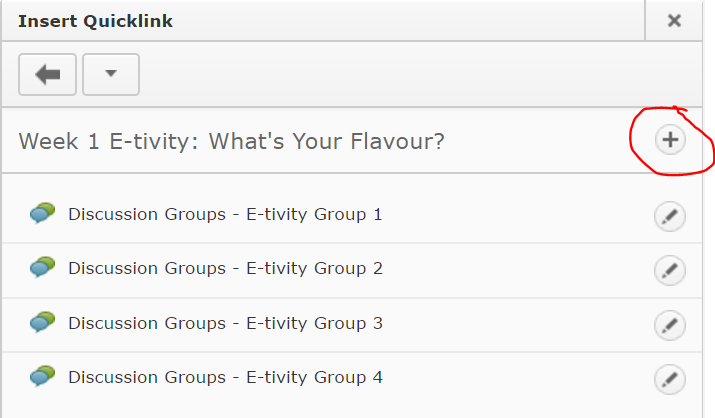 You cannot link to a thread using this method, though that is possible using the Url Quicklink option. |
| External Learning Tools > MyMedia Recordings (ALP) | Whole Window | Creates a link to your Echo360 Section, or to an individual recording in your section (Class). Once the Quicklink is created, you will need to save/preview your item, so that you can follow the link that you have created. You will then need to select the Section/Class you wish to link to take students to. Further instructions are available here for linking to a Section, or here for linking to a single recording (Class). |
| External Learning Tools > MyMedia Recordings (ALP) | Same Frame | Web Conferencing – creates a link to the Web Conferencing tool, so students can then launch the 24-7 room (by selecting the Join Room) or a session (by selecting the session name). |
| Quizzes | Whole Window | Note that students will receive an error message if they try to follow this link before the Start Date or after the End Date has been reached. You may like to mention this in the link text. For example: Please note that you will receive an error message if you try to access the Quiz before DATE/TIME or after DATE/TIME) |
| Surveys | Whole Window/New Window | If students have already completed the maximum number of attempts, they will see a message saying they have no more attempts left. |
| Unit File | New Window | Allows you to select a file from the Manage Files tool (if you have already uploaded the file to MyLO) OR to upload a file from your computer. Uploading a file from your computer via this Quicklink tool will NOT allow you to choose a Target behaviour. We have found this problematic in some cases. You may find it easier to upload files to Manage FIles before linking to them. Alternatively, upload them to a Module (folder) in Content, and link to them using the Content Quicklink. |
| Url | New Window | Allows you to link to a web address (URL). This is typically used to send students to a website outside of MyLO. |
| Equella Select or Add Item | No choice | Allows you to create and link to a new item in the university’s Digital Copyright Management System, known as Equella. You can also link to existing items. This system is generally used to house student readings (like PDFs of a chapter from a book or an article) that are not already available via the UTAS Library. |
| Web Conferencing | N/A | DO NOT USE: Use External Learning Tools option instead. |
Technical Issues Handy Hints
This article discusses common technical problems with MyLO and associated software and some handy ways to help!
Students can’t hear me in online room? (Blackboard Collaborate)
- While the Online Rooms are generally reliable the more common issues encountered with Online Rooms are around audio not working (lecturer or student).
- I have personally found that when a USB headset has worked in the past but is not working suddenly – unplug it from the USB port and plug back in. That sometimes fixes the issue.
- Consider having a ‘test and see’ session before the official start of Online Tutorials so that you and your students can test your equipment/browser etc.
- If one browser is not loading the room, try another. You may find particular browsers more reliable than others. Chrome is recommended however I have personally also found Firefox to be very reliable.
- Ensure your browser and any associated software (ie, Flash player) are up to date.
- It is hard to diagnose student audio problems, each set up is quite different – consider having some useful guides set up in your unit so that they can do some troubleshooting before contacting you or ITR. Ask your Ed-Tech to help set some up! (these are in the TSBE template by default).
Students can’t get to Grademark Feedback to view comments?
- Students won’t see their Grademark Feedback until the assignment is set to “published”.
- Students may have trouble getting into Grademark for Units that have gone past their End Date. (ie past the end of semester). This is a known issue for which the solution is, currently, for staff to go into the assignment & download the Grademark comments as PDF. For this reason it is useful to remind students to download any feedback they wish to keep before classes end.
Student can’t submit subsequent assignment files to a submission area?
- Occasionally staff may have students who have submitted one file to the Assignment Submission area then state they can’t submit again.
- Sometimes this is because they are not sure how to go back to do so.
- Sometimes it because the assignment settings only allow one submission.
- Sometimes it is because the ‘end-date’ has been reached.
- Check settings for submission and/or consider providing some help files. For students who are re-submitting files they need to click on the assignment name as they did the first time, many get lost when they click the link under ‘submissions’ instead.
Student’s file didn’t go through Turnitin?
- This is one of the most common staff questions regarding Turnitin.
- When a file does not go through the system it will show as a triangle icon with ! where the report icon would normally be.
- Hover your mouse over this icon for a small explanation of the issue.
- If the issue is “File does not contain valid text” it means the file cannot be read as text by the system. For example a PDF that has been created by scanning text with a scanner, or a scanned hand-written document. Your student will need to submit a file with electronic text – like a word document.
- Issues like “Could not contact server” can sometimes be resolved by clicking the small icon to the right of the ! This will resubmit the file to Turnitin.
- If you see “Invalid File type” or similar – it means the file is not the required type of file (ie, it might be a Zip or Video). Your student will need to resubmit an appropriate file.
- If the file shows a score of 0% and doesn’t load up the report in Turnitin you will need to lodge a service desk ticket.
Student states their Quiz crashed halfway through?
- By far and away the most common technical issue with quizzes is working out whether the students claim of the quiz crash is accurate and how to allow them another go.
- There is a way to view the “event log” in any quiz attempt. This shows when the quiz was entered, when each question was saved and whether the quiz was exited normally. Get to know how to access and interpret this log. [Click here for more information]
- You can resolve issues with attempts that are ‘stuck’ by following the instructions here [PDF].
- When allowing another attempt of a quiz the ‘Special Access’ now allows you to keep any original attempts by over-riding the maximum attempts allowed. [PDF]
Filter Grades or Assignment Submissions so you see only a particular group of students
You can filter your view of Grades and Assignment Submissions Folders to see only results or submissions from students enrolled in a particular group. This can be very useful if you are responsible for marking students in a particular unit code or tutorial group. Here’s how.
Go to the Grades tool by selecting Grades from the MyLO toolbar in your unit OR go to Assessments > Assignments and open the Submission Folder that you wish to view by clicking on its name.
Select Groups from the View by drop-down menu (User is usually the default), then select the Apply button.
You will now need to choose one Group from the Group drop-down menu.
Common types of default Group include:
- Campus Groups: e.g. Default Group Campus Hobart
Choose a group in this category to only view students based on a particular campus.
*Warning: students studying off-campus are also counted as ‘Hobart’ students. - Mode Groups: e.g. Default Group Study Mode External/Internal
Choose a group in this category to see students studying externally (off-campus) or interally (on-campus) The External group includes all students studying off-campus. The Internal group includes students studying on-campus. - Unit Groups: e.g. Default Group Unit HGA237
Useful when you have a MyLO Unit serving more than one unit code.
Once you have chosen a Group, select the Apply button again.
You should now see only Grades/Submissions for those students who are members of your chosen Group. MyLO will generally remember this setting the next time you return to the Grades tools or Assignment Submission Folder using the same device.
To view all students again, select Users from the View By menu, then select the Apply button.
Mark with a Text Only (feedback) Rubric
A Text Only Rubric has no points associated with criterion and levels. Unlike a Custom Points Rubric, this type of Rubric will NOT calculate a score or Overall Level for you. You must select a level of achievement against each criterion, then specify and Overall Level.
Please note that the ‘look’ of a Rubric may change depending on whether you are marking from an Assignment Submission Folder or from a Grade Item. We have represented this by providing two screen shots for each instruction: the view from an Assignment Submission Folder is always presented in the first image; the view from a Grade Item is always presented in the second image.
Please note that these instructions do not explain how to access a Rubric. You can see how to access a Rubric from an Assignment Submission Folder here, or from a Grade item here.
Choose a level for each criterion
Choose a level for each criterion by clicking on it. When marking a Rubric from an Assignment Submission Folder, you will notice that the selected level is highlighted by a selected radio button (see first image). When marking from a Grade Item the selected level will be highlighted, and a small check mark will appear in the bottom right corner (see second image). To change the level, simply click on a different level.
Edit the feedback associated with a level
If you wish to provide a student with feedback in relation to a particular criterion, first select the level. You will notice that an editing icon appears. When marking from an Assignment Submission Folder, this icon will appear in the far right column (see top image). When marking from a Grade Item, you will need to select the + FEEDBACK link that appears in the far left column (see bottom image).
The editing views are slightly different. If you are marking from an Assignment Submission Folder, a new dialogue box will open. Here, you can record feedback if required (see top image). If you are marking from a Grade Item, you will see a Criterion Feedback field open at the bottom of the selected level. Type in your feedback, then select DONE to save it and keep marking.
From time to time, remember to click the Save button to save your work (appears underneath the Rubric).
Choose an Overall Level
Once you have chosen levels against each criteria, you will need to select an Overall Level. To do this, select one of the level fields in the bottom row of the Rubric.
Save the Rubric
- If you’re marking from an Assignment Submission Folder, uncheck the Transfer rubric feedback to general feedback for the assignment option (this option is not very useful).
- Finally, select the Save & Record button.
The overall score from the Rubric will not be reflected in the Evaluation Score field in an Assignment Submission Folder (see first image) or in the Grade field in a Grade Item (see second image). You will need to record the score manually. Remember to Save your work after recording the score.
Mark with a Custom Points Rubric (generates a score)
This post covers marking with a rubric that has been set up as a “Custom Points” rubric and that has been attached to either an assignment, discussion or grade item.
A Custom Points Rubric has points associated with each criterion and level of the Rubric. It calculates a total score (and overall level) for a student by adding the points they have scored against each criterion. You are then able to fine-tune this score by overwriting the default scores for each criteria/overall.
This post doesn’t cover setting up the rubric. If you have not done so – set up your rubric following these instruction: (Create a custom points rubric).
To access the rubric for each tool:
Assignment: Click “Evaluate” (or ‘draft saved’) on the right side of the screen in the assignment. The rubrics are then shown as links on the right-side menu area.
Discussion: Click the [v] icon next to the Topic you are assessing then choose “Assess Topic”. From the list of students shown click “Topic Score” and the rubric is shown on the top of the window that loads.
Grade Item (ie, directly into the gradebook): Click the [v] next to the name of the grade and choose “Grade All”. From the window that loads you will see a link to the rubric on the right-side column for each student row.
Note: The Rubric tool will save your work as you go. It is also not possible to edit the rubric in the rubric tool once you’ve started marking, so be sure to preview it in the rubric tool before you start marking to ensure it is correct.
Step 1: Click the ‘level’ for each criteria that best represents the Feedback you wish to provide to students about their work.
The rubric tool is essentially a “feedback” tool – useful for you to calculate a score but primarily the idea is to provide students with useful informative feedback about why the score was arrived at.
The “default” score associated with this level (as set up in the rubric tool) is then shown on the right of the rubric window. You may need to resize this window if you have a large rubric, or scroll sideways to see it.
Step 2: Edit the points and feedback associated with a level if required.
Once you’re happy with the criteria levels you’ve chosen to provide to students – you can then alter the score associated with either each level OR the overall score that was calculated.
To edit the score for an individual criteria click on the score as shown on the right of the rubric. Type your new number in and hit enter/return or click elsewhere. Your new score will be highlighted with an asterix to indicate the default was changed. The ‘x’ shown next to the new score will return this score to the default.
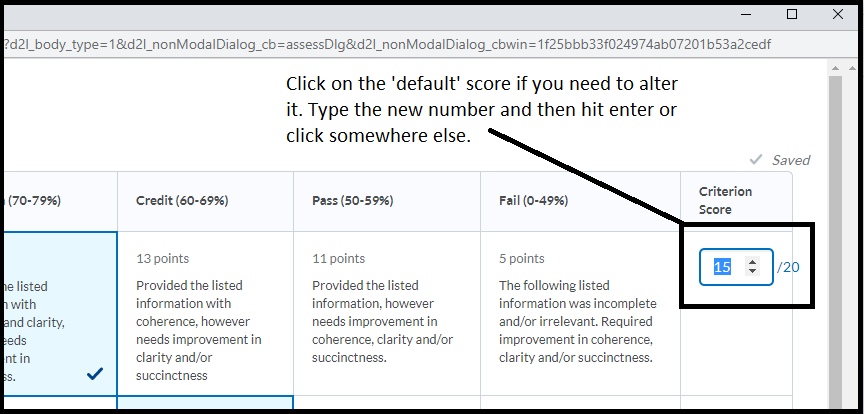
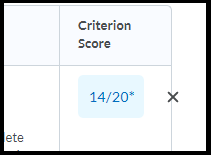 (Showing the score was changed from the default, the X returns the score to the default)
(Showing the score was changed from the default, the X returns the score to the default)
To add written feedback click the ‘add feedback’ link on the left, a box will appear for you to type into. Please note, once you add written feedback here it stays put on the page. Don’t click the X unless you want to wipe what you’ve written*.
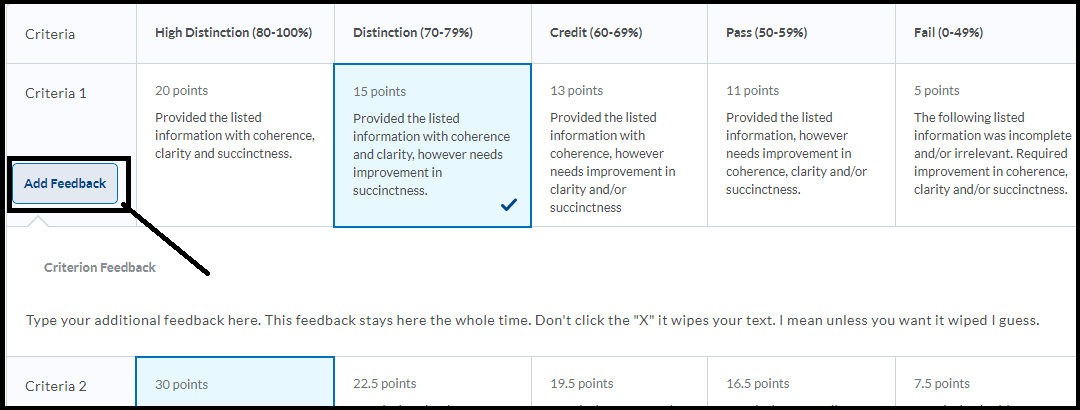
Step 3: Check the total at the lower part of the rubric. You can also overwrite this score by clicking on it & typing a new score. You can overwrite the default chosen ‘level’ if your rubric has them – click on the new one to overwrite the default.
Step 4: Click “Close” button at the end of the rubric to finalise the process. Double check the correct score is sent to the ‘score’ field of the tool you’re working in. If it doesn’t – it usually means you have missed a criteria.
* Don’t ask me why it was designed like that, I have no idea why the standard computer logic of x=close was broken for this tool – but here we both are, sighing loudly and reaching for the schnapps.
Mark Using Rubric from an Assignment Submission Folder submission
Step 1
Go to the Assignments tool from the toolbar.
Click on the assignment you wish to mark.
Step 2
A new page will load. Scroll down until you see a list of student submissions. The student’s names will appear, followed by the files they have submitted. You can view an individual file by clicking on the file name (this is usually the quickest option, especially if students have submitted cover sheets which you do not have to mark).
A preview of the student’s work will load, as the screenshot below shows the content of the assignment will appear to the left, the “Evaluation” area to the right.
Step 3
Click on the name of the rubric to load it up – it will appear in a new window. You may need to resize the window to see the whole rubric. The example below shows a “Custom Points” rubric, this being the most commonly used rubric.
You will see the list of criteria and levels arranged somewhat like above (yours is likely to have more text than this example). To “choose” a level just click the radio button. It is more important to choose the option that contains the most relevant feedback for your student – the default score can be altered.
To alter the score click the Pencil icon – over on the right of the rubric – then enter an alternate score and/or optional feedback text. When you do this you’ll notice a small icon (see above, the second criteria shows as red shaded and an icon in the ‘Score and Feedback’ area indicating that a ‘custom’ score was entered for this criteria.
To have the rubric fully calculate a score you MUST choose an option for EVERY criteria.
When you have completed the rubric choose “Save and Record” to send the score to the ‘Score’ field of the assignment (which then is sent to grades).
(The option you see in the screenshot ‘Transfer rubric feedback’ relates to any text you have typed that gets transferred to the “Feedback” area, this option is on by default but is optional).
When you click Save and Record you will see the score appear in the ‘Score’ field. If none appears it may mean there is a score missing for one of the criteria. You can click on the rubric at any time to edit/alter the mark – just remember to hit save and record each time.
As you can see from the above screenshot the rubric score that was calculated – when I click ‘Save and Record’ – is sent to the ‘Score’ field. You can always alter the score here too if you want.
Remember if you are marking and do not want to release the score to students YET – click ‘Save Draft’.
Instructions showing how to mark with a Text Only Rubric (for feedback only) are available here.
Change your Dialog Setting to increase ease of marking with a Rubric
In the past, when marking a submission to an Assignment Submission Folder, a Rubric would open over the top of a student’s work. To get back to the student’s work, you would either have to save and close the Rubric, or open Grademark in a new browser tab so that you could view the student’s work in one tab and view the Rubric in another tab. Tedious! A personal Dialog setting in MyLO allows you to choose to open ‘dialogue boxes’ in a new window (or pop-up). This means that a Rubric will open in a new window so you can minimise it while looking at a student’s work, move it around your screen easily, or maximise the window so you can see the whole Rubric easily. Yay! To see a demonstration of the difference this setting makes, view this brief video (02:46, opens in new window).
Follow these instructions to change the setting.
Step 1
Towards the top right of your screen, you should see your name. Click the arrowhead to the left of your name, then select Account Settings.
Step 2
Scroll down until you see Dialog Setting heading. Choose the Pop-ups option from the Show secondary window as option, as seen below. Select the Save and Close button (bottom of the screen).
You’re done!
Tool Review: Rubrics
What does it do?
The Rubrics tool can create rubrics for assessment and feedback purposes. Many academics have reported that using electronic Rubrics makes the process of marking, feedback and moderation far more efficient. The following table compares the two most common types of MyLO Rubrics: Analytic > Text Only; and Analytic > Custom Points. Alternatively, this video demonstrates the two Rubric types, and points out the main differences between them (4:25, opens in new window).
Tool capabilities
Helpful resources and instructions
- Samples of rubrics
- Samples of assessment criteria for online Discussion activities
- Create a MyLO Rubric that will calculate a Grade (Custom Points Rubric)
- Create a MyLO Rubric to provide feedback (Text Only Rubric)
- Attach a Rubric to an Assignment Submission Folder so you can mark with it
- Attach a Rubric to a Grade Item so you can mark with it (best for Discussions or Presentations)
- Access a Rubric from an Assignment Submission Folder submission (when marking)
- Access a Rubric from a Grade Item (when marking)
- Mark with a Text Only (feedback) Rubric
- Mark with a Custom Points Rubric (generates a score)
- Override the score generated by a Custom Points Rubric
- Use Rubric statistics to assist with assessment moderation

